This article includes a list of general references, but it lacks sufficient corresponding inline citations. (April 2010) |
| First Sudanese Civil War | |||||||
|---|---|---|---|---|---|---|---|
| Part of the Sudanese Civil Wars and the South Sudanese wars of independence | |||||||
 Sudan (red) before 2011; the first civil war took place in the country's south | |||||||
| |||||||
| Belligerents | |||||||
|
(1955–1956) (1956–1969) (1969–1972) Combat support: (Joint operations on Ugandan territory, 1965–1969)[1] (From 1969 and combat involvement at least in 1970)[2] Non-combat support: |
Supported by: | ||||||
| Commanders and leaders | |||||||
|
|
| ||||||
| Strength | |||||||
|
Sudanese Armed Forces: 6,000–7,000 (1955)[18] 36,000 (late 1971)[19] |
6,000–12,000[20] c. 18,000 (late 1960s)[11] | ||||||
| Casualties and losses | |||||||
| 500,000[21]–1 million[22] killed including 100,000+ combatants[23] | |||||||
The First Sudanese Civil War (also known as the Anyanya Rebellion or Anyanya I, after the name of the rebels, a term in the Madi language which means 'snake venom')[24] was fought from 1955 to 1972 between the northern part of Sudan and the southern Sudan region which demanded representation and more regional autonomy. The war was divided into four major stages: initial guerrilla warfare, the creation of the Anyanya insurgency, political strife within the government, and establishment of the South Sudan Liberation Movement. Around a million people died over the course of the nearly 17-year long war.
Although the Addis Ababa Agreement ended the war in 1972, it failed to completely dispel the tensions and addressed only some of the issues stated by southern Sudan. The breakdown of the initial appeasement later led to a reigniting of the north–south conflict during the Second Sudanese Civil War, which lasted from 1983 to 2005.
- ^ Poggo (2009), p. 151.
- ^ a b Poggo (2009), p. 166.
- ^ a b c d e f Poggo (2009), p. 1.
- ^ OBallance 1977, p. 119-120.
- ^ a b c d e f g h Poggo (2009), p. 155.
- ^ a b Poggo (2009), p. 165.
- ^ Martell (2018), p. 72.
- ^ Martell (2018), pp. 79–82.
- ^ a b Johnson, Douglas (2011). The Root Causes of Sudan's Civil Wars: Peace Or Truce. Boydell & Brewer Ltd. pp. 36–37. ISBN 978-1847010292.
- ^ Leach, Justin (2012). War and Politics in Sudan: Cultural Identities and the Challenges of the Peace Process. I.B.Tauris. p. 178. ISBN 978-1780762272.
- ^ a b c d Martell (2018), p. 89.
- ^ Acig.org. "Sudan, Civil War since 1955".
- ^ Poggo (2009), p. 158.
- ^ Poggo (2009), p. 163.
- ^ OBallance 1977, p. 143-44.
- ^ Shinn, David H, "Addis Ababa Agreement: was it destined to fail and are there lessons for the Current Sudan Peace Process?", p. 242
- ^ Martell (2018), pp. 80–81.
- ^ Sudanese MOD website, http://www.mod.sd[permanent dead link], via Wayback Machine.
- ^ OBallance 1977, p. 119.
- ^ Matthew LeRiche, "Sudan, 1972-1983," in "New Armies from Old: Merging Competing Military Forces After Civil Wars," ed Licklider, 2014, 34.
- ^ De re Militari: muertos en Guerras, Dictaduras y Genocidios. Capítulo I.
- ^ Martell (2018), p. 14.
- ^ Matthew LeRiche, Matthew Arnold. South Sudan: from revolution to independence. 2012. Columbia University Press. New York. p. 16. ISBN 978-0-231-70414-4
- ^ Matthew LeRiche, Matthew Arnold. South Sudan: from revolution to independence. 2012. Columbia University Press. New York. p. 16. ISBN 978-0-231-70414-4